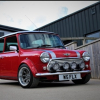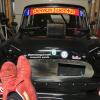The steering column danger was recognised back in the mid-'50's when, as said, cars like the Jag XK's, the TR range, the Healey 3000, etc, could 'spear' the driver with the steering column in a frontal impact - rather unpleasant. This was probably the first time crash damage was considered during design.
However, deformable body structure didn't really come into being until much later with progressive deformation of frontal structure. In fact, in a straightforward roll over a classic Mini is quite good. It is front, side and rear impacts where it is lacking and a roll cage will not really take care of that.
There is another major safety issue with the Mini which is more critical than roll-over strength. The fuel tank is in the boot and the boot is not isolated from the interior of the car. There is a gap at each end of the rear seat back panel and, on earlier cars, there is a hole in that panel covered with a piece of cardboard plus a couple of speaker holes in the back shelf. In the event of a heavy rear end shunt the filler neck can be damaged as it sticks out and is not recessed as required on modern cars. At the front the engine bay is not isolated from the interior, so any fumes from a damaged exhaust or an engine bay fire can gain instant ingress into the car. These are all things which have to be accepted when driving classic cars in general and the classic Mini in particular. If you can't accept them then don't drive one - simples!
I guess those of us who grew up with 1950's & 1960's cars have accepted the safety limitations and don't really consider them. For competition use classics have to have certain safety engineering done, such as sealing up the fuel tank and engine bay areas from the interior. This includes removing the fresh-air ducting which, on a Mini, runs with plastic parts through the engine bay and into the car! How stupid is/was that?
There are so many things which render a classic car unsafe in comparison with modern vehicle engineering and it is not possible to re-engineer a classic to provide modern protection.
On a lighter note, my first car was a 1950 Ford V8 Pilot (Google it maybe). It had a 3.6 litre flat-head V8 engine, weighed a lot, did 90 mph, had cross-ply tyres and drum brakes with the rears being rod-actuated. The wipers were vacuum operated and there were no internal safety features - not even seat belts. I always say that it taught me to drive because I had to look so far down the road and pay attention. But I never had a crash in it or even scratched it. When I got my first Mini, an 850, in 1963 I thought that it was super-safe because it went, cornered and stopped so much better than the Pilot. It may be hard to realise now how safe the Mini seemed, and indeed was, back in the early 1960's, especially when first fitted with radial ply tyres. In a Mini you could actually steer your way out of trouble as often as not.






















